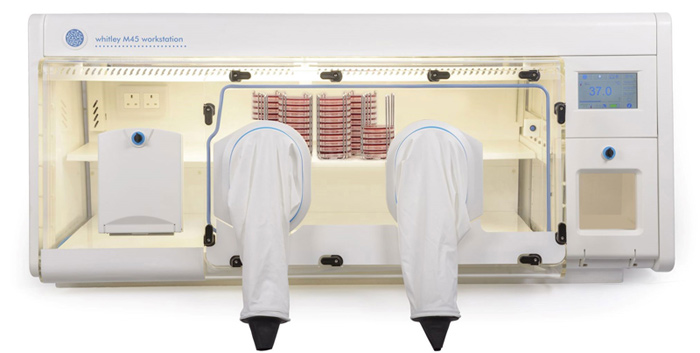A sustainable microaerophilic environment for incubation and manipulation of microbiological samples is crucial to culturing Campylobacter jejuni, Helicobacter pylori, and other fastidious pathogens. The ability to provide a customizable low level of oxygen for pathogens that can’t be cultivated successfully in ambient air or under strictly anaerobic conditions is a prerequisite for culturing these microorganisms.
The M series microaerophilic workstations by Don Whitley Scientific, distributed in North America by Microbiology International, provide precise gas control of up to four gasses for a customizable low oxygen environment that doesn’t require expensive custom gas mixes. The entire temperature-controlled interior of the chamber serves as the work and incubation area, ensuring that growing cultures are never exposed to ambient conditions. Though the robust MACS VA workstations are still being used in many laboratories, we have invested considerable resources into developing the next generation microaerophilic workstation, the M series, with increased atmospheric precision and a touchscreen interface. A range of sizes with capacities from ~600 to ~1400 plates will accommodate every workflow and space requirement. Options such as data logging, internal HEPA filtration, HEPA containment, gas pressure monitoring and automated humidity control provide protection and accountability.
Clinics and research institutions worldwide are using our microaerophilic workstations to cultivate fastidious microorganisms with confidence. Researchers are taking advantage of the stable microaerophilic atmosphere generated in our workstations to investigate the expression of H. pylori toxin in gastric pathology, integration of selected genes onto the C. jejuni chromosome, spectroscopic differentiation of foodborne Campylobacter strains and the epidemiology of antibiotic-resistance in Campylobacter in cattle.
Please feel free to contact us with any questions that you may have about our microaerophilic workstations.

2016 Horemans et al. In-vivo evaluation of apocynin for prevention of Helicobacter pylori-induced gastric carcinogenesis
2016 Fontenete et al. Fluorescence In Vivo Hybridization (FIVH) for Detection of Helicobacter pylori Infection in a C57BL/6 Mouse Model
2016 Sinnett et al. Helicobacter pylori vacA transcription is genetically determined and stratifies the level of human gastric inflammation and atrophy
2016 Su et al. Combination of OipA, BabA, and SabA as candidate biomarkers for predicting Helicobacter pylori-related gastric cancer
2016 Muhamadali et al. Chicken, beams, and Campylobacter : rapid differentiation of foodborne bacteria via vibrational spectroscopy and MALDI-mass spectrometry
2015 Jervis et al. Chromosomal integration vectors allowing flexible expression of foreign genes in Campylobacter jejuni

